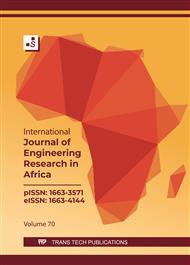[1]
F. G. Alabtah, E. Mahdi, F. F. Eliyan, The use of fiber reinforced polymeric composites in pipelines: A review, Composite Structures, 276 (2021) 114595.
DOI: 10.1016/j.compstruct.2021.114595
Google Scholar
[2]
J.M.L. Reis, A.R. Costa, H.S. da Costa Mattos, Repair of damage in pipes using bonded GFRP patches, Composite Structures, 296 (2022) 115875.
DOI: 10.1016/j.compstruct.2022.115875
Google Scholar
[3]
D. Yang, S. Dong, C. Hong, X. Zhang, Preparation, modification, and coating for carbon bonded carbon fiber composites: A review, Ceramics International, 48 (2022) 14935-14958.
DOI: 10.1016/j.ceramint.2022.03.055
Google Scholar
[4]
K.S. Lim, S.N. Afifah Azraai, N. Yahaya, N.M. Noor, L.Zardasti, J.H. Jay Kim, Behavior of steel pipelines with composite repairs analyzed using experimental and numerical approaches, Thin-Walled Structures, 139 (2019) 321-333.
DOI: 10.1016/j.tws.2019.03.023
Google Scholar
[5]
M.M. Benziane, S. A. Abdul-Wahab, H. Zahloul, B. Babaziane, M. Hadj-Meliani, G. Pluvinage, Finite element analysis of the integrity of an API X65 pipeline with a longitudinal crack repaired with single- and double-bonded composites, Composites Part B, 77 (2015) 431e439.
DOI: 10.1016/j.compositesb.2015.03.008
Google Scholar
[6]
F. Qingshan, D. Lianshuang, Revelation of Pipeline Accidents, China Building Materials Press, (2016) 5-15.
Google Scholar
[7]
E. Olsø, E. Berg, K. Holthe, B. Nyhus, B. Skallerud, C. Thaulow, et al., Effect of embedded defects in pipelines subjected to plastic strains during operation. In: Proceedings of the International Offshore and Polar Engineering Conference, (2008) 143e8.
Google Scholar
[8]
X. Qian, KI-T estimation for embedded flaws in pipes - Part II: circumferentially oriented cracks. Int J Press Vessels Pip, 87(4) (2010) 150e64.
DOI: 10.1016/j.ijpvp.2010.03.004
Google Scholar
[9]
E. Abdelouahed, M. Mokhtari, H. Benzaama, Finite Element Analysis of the thermoMechanical Behavior of composite Pipe Elbows under Bending and Pressure loading, Frattura ed Integrità Strutturale, 49 (2019) 698-713.
DOI: 10.3221/igf-esis.49.63
Google Scholar
[10]
Je H., Kimura A., Stress corrosion susceptibility of oxide dispersion strengthened ferritic steel in supercritical pressurized water dissolved with different hydrogen and oxygen contents, Corros. Sci., 78 (2014) 193-199, https://doi.org/10.1016/j. corsci.2013.09.016.
DOI: 10.1016/j.corsci.2013.09.016
Google Scholar
[11]
M.A. Sohail, K. Mahir Essaheb, Effect of Patch Thickness on the Repair Performance of Bonded Composite Repair in Cracked Aluminum Plate, ICAAMM-2016, Materials Today: Proceedings, 4 (2017) 9020-9028.
DOI: 10.1016/j.matpr.2017.07.255
Google Scholar
[12]
A. Baker, A.J. Gunnion, J. Wang, P. Chang, Advances in the proof test for certification of bonded repairs – Increasing the technology readiness level. International Journal of Adhesion and Adhesives, 64 (2016) 128-141.
DOI: 10.1016/j.ijadhadh.2015.10.008
Google Scholar
[13]
E. Abdelouahed, H. Benzaama, M. Mokhtari, B. Aour, Pipeline repair by composite patch under temperature and pressure loading, Frattura ed Integrità strutturale, 49 (2019) 690-697.
DOI: 10.3221/igf-esis.49.62
Google Scholar
[14]
K. Sadek, M.S. Bennouna, B. Aour, B.A. Bachir Bouiadjra, A. Benaissa, M. Fari Bouanani, Numerical Investigation of the Adhesive Damage Used for the Repair of A5083 H11 Aluminum Structures by Composites Patches, International Journal of Engineering Research in Africa, 44 (2019) 22-31.
DOI: 10.4028/www.scientific.net/jera.44.22
Google Scholar
[15]
A.A. Baker, R. Jones, Bonded repair of aircraft structures. Martinus Nijhoff,Publishers, 1988.
Google Scholar
[16]
P.C. Tse, K.J. Lau, W.H. Wong, Stress and failure analysis of woven composite plates with adhesive patch-reinforced circular hole. Compos Part B: Eng., 33(1) (2002) 57e65.
DOI: 10.1016/s1359-8368(01)00060-9
Google Scholar
[17]
F.Benyahia, M.Fari Bouanani, A.Albedah, B.Bachir Bouiadjra, T.Achour, Effect of water absorption on the adhesive damage in bonded composite repair of aircraft structures, Materials and Design, 57 (2014) 435-441.
DOI: 10.1016/j.matdes.2013.12.081
Google Scholar
[18]
A. Amr Abd-Elhady, H.E.M. Sallam, I.M. Alarifi, R.A. Malik, T.M.A.A. EL-Bagor, Investigation of fatigue crack propagation in steel pipeline repaired by glass fiber reinforced polymer, Composite Structures 242 (2020) 112189.
DOI: 10.1016/j.compstruct.2020.112189
Google Scholar
[19]
G. Vizentina, G. Vukelic, Failure analysis of FRP composites exposed to real marine environment, ICSI 2021, The 4th International Conference on Structural Integrity, Procedia Structural Integrity 37 (2022) 233–240.
DOI: 10.1016/j.prostr.2022.01.079
Google Scholar
[20]
A. Behera, P. Dupare, M.M. Thawre, A. Ballal, Effects of hygrothermal aging and fiber orientations on constant amplitude fatigue properties of CFRP multidirectional composite laminates, International Journal of Fatigue, 136 (2020) 105590.
DOI: 10.1016/j.ijfatigue.2020.105590
Google Scholar
[21]
ISO/TS 24817:2017: Petroleum, petrochemical, and natural gas industries. Composite repairs for pipe work. Qualification and design, installation, testing, and inspection. Standard; International Organization for Standardization, Geneva, Switzerland; 2017.
DOI: 10.3403/30339673
Google Scholar
[22]
The American Society of Mechanical Engineers. ASME PCC-2-2015. Repair of pressure equipment piping; 2015.
Google Scholar
[23]
M.F. Köpple, S. Lauterbach, W. Wagner, Composite repair of through-wall defects in pipe work - Analytical and numerical models with respect to ISO/TS 24817. Composite Structures, 95 (2013) 173-178.
DOI: 10.1016/j.compstruct.2012.06.023
Google Scholar
[24]
V.M. Karbhari, Rehabilitation of Metallic Civil Infrastructure Using Fiber Reinforced Polymer (FRP) Composites: Types Properties and Testing Methods, 1st Edition, Woodhead Publishing, 2014.
DOI: 10.1533/9780857096654.1.3
Google Scholar
[25]
Y.J. Kim, J.S. Kim, Y.J. Park, Y.J. Kim, Elastic-plastic fracture mechanics method for finite internal axial surface cracks in cylinders. Eng. Fract. Mech., 71 (2004) 925-944.
DOI: 10.1016/s0013-7944(03)00159-0
Google Scholar
[26]
Tous les matériaux pour la Recherche, l'Industrie et la Production ''http://www. goodfellow.com'', 15/01/2019.
Google Scholar
[27]
M. Bordes, Aging of adhesive joints in a marine environment for offshore applications, (2009) PhD thesis, INSA Lyon (in French).
Google Scholar
[28]
S. Kotera, M. Yamaguchi, Rheological characterization on thermal degradation of ethylene-tetrafluoroethylene copolymer, Journal of Fluorine Chemistry, 166 (2014) 117–121.
DOI: 10.1016/j.jfluchem.2014.07.020
Google Scholar
[29]
N.S. Zakaria, Z.M.A. Merican, M.F. Hamza, Performance and Critical Issues of Polymer Liners in Pipeline Industry: A review, Materials Today: Proceedings, 16 (2019) 2389-2397.
DOI: 10.1016/j.matpr.2019.06.143
Google Scholar
[30]
K. Sadek, B. Aour, B.B. Bouiadjra, M. Fari Bouanani, F. Khelil, Analysis of Crack Propagation by Bonded Composite for Different Patch Shapes Repairs in Marine Structures: A Numerical Analysis, Int. J. Eng. Res. Afr. 35 (2018) 175-184.
DOI: 10.4028/www.scientific.net/jera.35.175
Google Scholar
[31]
Kaddour, S., Aour, B., Bennouna, M. S., Talha, A. ., Bachir Bouiadjra, . B., & fari bouanani, . M. (2020). The Effect of corrosion on the quality repair of the aluminum alloy A 5083 H11 by bonded composites. Frattura Ed Integrità Strutturale, 14(53), 51–65.
DOI: 10.3221/IGF-ESIS.53.05
Google Scholar


